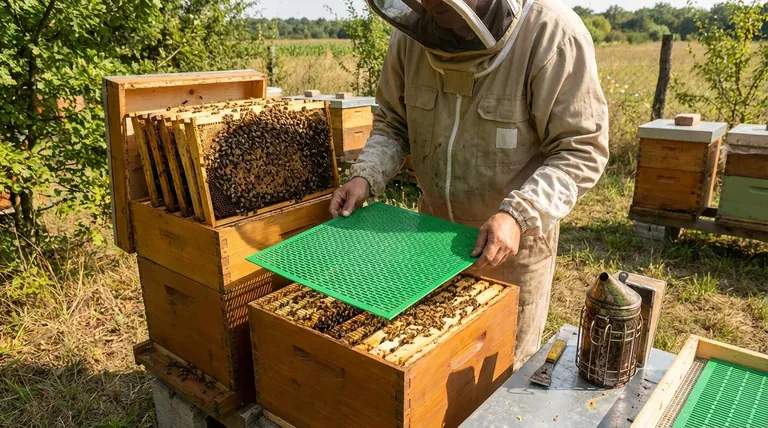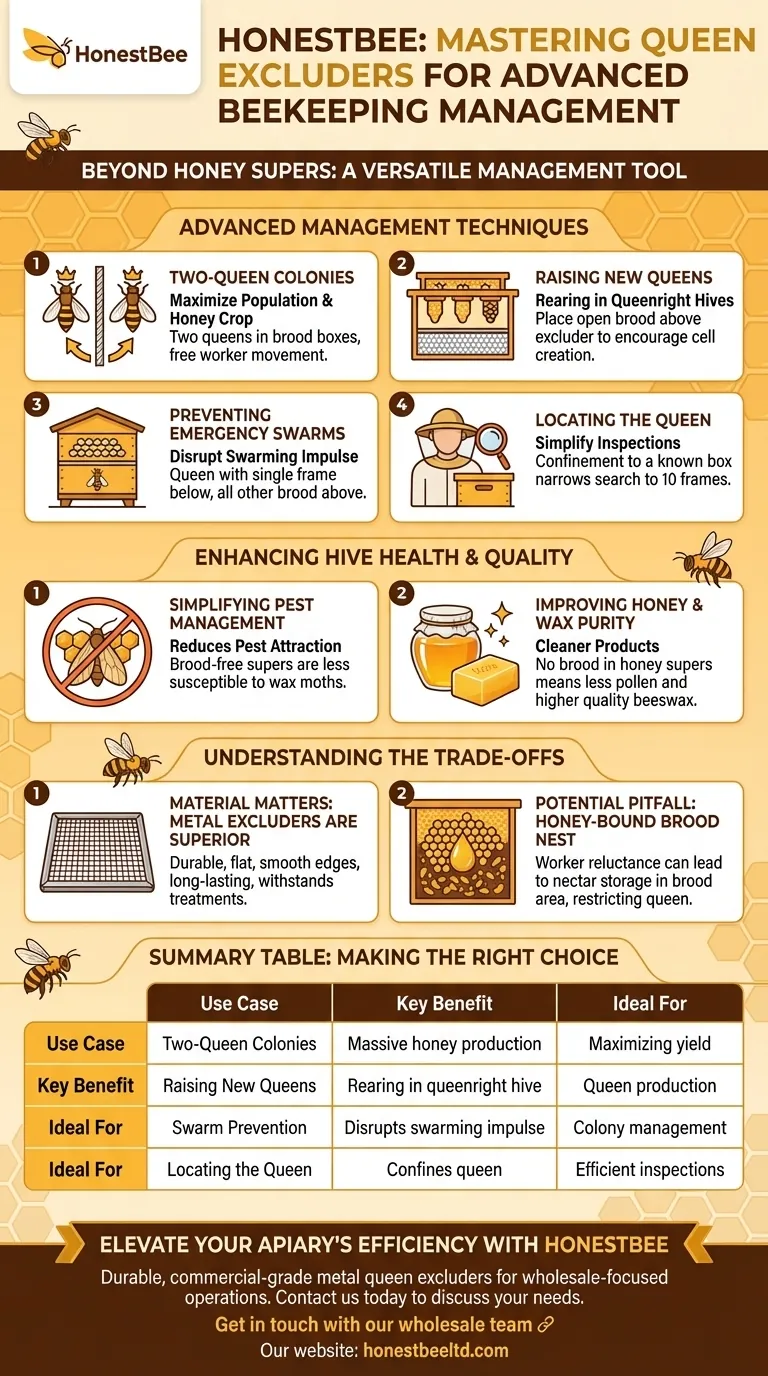Beyond its primary function, a queen excluder serves as a versatile management tool for advanced beekeeping techniques. These include separating queens in a two-queen colony, raising new queens in a queenright hive, implementing emergency swarm prevention measures, and simplifying the process of locating the queen within the hive.
The queen excluder is far more than a simple barrier for honey supers. It is a strategic device that allows a beekeeper to control the colony's internal structure, enabling precise management of population, reproduction, and space.

Beyond Honey Supers: Advanced Management Techniques
While most beekeepers use an excluder to keep the queen from laying eggs in honey supers, its true value lies in more sophisticated applications that give you greater control over the colony.
Creating Two-Queen Colonies
A queen excluder can be placed between two brood boxes, each containing a queen. This setup allows the worker bees to move freely throughout the entire hive while keeping the queens separated. The result is a massive population that can produce an exceptionally large honey crop.
Raising New Queens
You can use an excluder to raise new queens without making a colony queenless. By placing the queen and open brood below the excluder and frames with young larvae or eggs above it, you can encourage the "queenless" bees in the top box to create queen cells. This is a common method for grafting and queen rearing in a strong, queenright colony.
Preventing Emergency Swarms
If you spot swarm cells, an excluder can be used for emergency swarm control. By placing the queen on a single frame of comb in a box below the excluder, and moving all the brood frames above the excluder, you can disrupt the swarming impulse. The bees perceive the queen as being gone from the main brood area, and they will tear down the swarm cells.
Locating the Queen with Ease
Finding the queen in a populous hive can be a time-consuming task. You can place a queen excluder between your brood boxes and return in three to four days. The box containing new eggs is the one with the queen, narrowing your search from twenty frames down to ten.
Enhancing Hive Health and Product Quality
Using an excluder provides secondary benefits that improve the quality of your hive products and simplify health management.
Simplifying Pest Management
Wax moths are primarily attracted to combs that have contained brood. By using an excluder to ensure honey supers remain brood-free, you significantly reduce their attractiveness to these pests.
Improving Honey and Wax Purity
When the queen cannot lay in honey supers, the resulting combs are used exclusively for nectar. This produces cleaner honey with less pollen contamination and results in higher-quality, lighter-colored beeswax upon rendering.
Understanding the Trade-offs
While powerful, queen excluders are not without their considerations. Understanding the material and potential downsides is key to using them effectively.
The Importance of Material and Design
Metal excluders are widely considered superior. They are robust, durable, and can last for decades. Their edges are typically smooth, reducing the risk of wing and leg damage to your worker bees as they pass through.
Metal excluders also sit perfectly flat and do not sag over time, maintaining the correct bee space. Furthermore, they are easy to clean with a hive tool or even heat, and they can withstand treatments like gamma irradiation without damage.
Potential for a "Honey-Bound" Brood Nest
One common pitfall is that worker bees, reluctant to cross the excluder, may begin storing nectar in the brood chamber. This can "honey-bind" the nest, restricting the queen's laying space and potentially slowing colony growth if not managed properly.
Making the Right Choice for Your Goal
Ultimately, how you use a queen excluder depends entirely on your specific objective for the colony.
- If your primary focus is maximizing honey production: Use the excluder to keep honey supers brood-free for simple extraction or to manage a two-queen system for a massive workforce.
- If your primary focus is queen rearing or swarm control: Use the excluder as a strategic tool to vertically divide the colony and manipulate the bees' reproductive instincts.
- If your primary focus is simplified inspections: Use the excluder to confine the queen to a known area, drastically reducing the time it takes to find her and assess the brood.
Mastering the queen excluder transforms it from a passive gate into an active instrument for precise beekeeping.
Summary Table:
| Use Case | Key Benefit | Ideal For |
|---|---|---|
| Two-Queen Colonies | Massive honey production | Maximizing yield |
| Raising New Queens | Rearing in a queenright hive | Queen production |
| Swarm Prevention | Disrupts swarming impulse | Colony management |
| Locating the Queen | Confines queen to a specific area | Efficient inspections |
Ready to elevate your apiary's efficiency and productivity?
For commercial apiaries and beekeeping equipment distributors, the right tools are critical for success. HONESTBEE supplies durable, commercial-grade beekeeping supplies and equipment through wholesale-focused operations. Our robust metal queen excluders are designed for precision and long-term performance, helping you implement advanced management techniques with confidence.
Contact us today to discuss your wholesale needs and discover how our equipment can support your large-scale beekeeping goals.
Get in touch with our wholesale team →
Visual Guide

Related Products
- High Performance Plastic Queen Excluder for Beekeeping and Apiary Management
- Professional Plastic Queen Excluder for Modern Beekeeping
- Wooden Queen Bee Excluder for Beekeeping
- Premium Wood Framed Metal Wire Queen Bee Excluder
- Plastic Queen Bee Excluder for Bee Hive Wholesale
People Also Ask
- Why don't all beekeepers use Queen Excluders? Balancing Honey Purity with Hive Productivity
- How does a queen excluder affect honey storage? Maximize Clean Honey Yields in Your Hive
- When should I remove my queen excluder? Timing is Critical for Winter Bee Survival
- When is the best time to place a queen excluder? Optimize Honey Production & Purity
- What happens if I don't use a queen excluder? Understand the impact on your honey harvest.



















